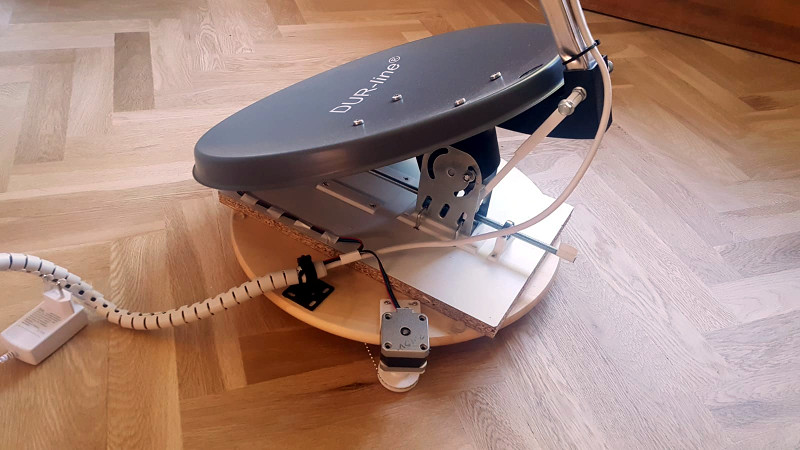We are used to imagining radio telescopes as immense pieces of scientific apparatus, such as the Arecibo Observatory in Puerto Rico, or the Lovell telescope in the UK. It’s a surprise then that they can be constructed on a far more modest sale using off-the-shelf components, and it’s a path that [Gonçalo Nespral] has taken with his tiny radio telescope using a satellite dish. It’s on an azimuth-elevation mount using an Ikea lazy susan and a lead screw, and it has a satellite TV LNB at the hot end with a satellite finder as its detector.
So far he’s managed only to image the wall of his apartment, but that clearly shows the presence of the metal supporting structure within it. Taking it outdoors has however not been such a success. If we wanted to hazard a guess as to why this is the case, we’d wish to look at the bandwidth of that satellite finder. It’s designed to spot a signal from a TV broadcast bird over the whole band, and thus will have a bandwidth in the hundreds of MHz and a sensitivity that could at best be described as a bit deaf. We hope he’ll try a different path such as an RTL-SDR in the future, and we look forward to his results.
This isn’t the first simple radio telescope we’ve seen here, aside from at least one other LNB-based one we’ve also shown you a WiFi device.
















“… modest scale…” vs “… modest sale…”? Maybe was meant to be. I know all the dish’s I salvaged were all free. :-|)
Awesome to see a lazy suzan design. I’ve not seen any others that look sort of like a Dobsonian mount I’ve been procrastinating about. I did receive the teflon material and since the cost of the 14-16″ old hard disc platters are so much… I opted for two laser discs to make my first mount. Found there are Fab Labs that just opened up in the areas I live and work too.
The only thought that comes to my admittedly inexpert mind is that a larger dish could provide more gain.
I’m sure he might have an idea of actually using several of them spread across a wider area….
So he designed a spy device that anyone can use looking into any building…
Was this posted twice for some reason?
So the question to all the RF-freaks is : How hard would it be to build something like this for the 21 cm band? You know, looking at hydrogen clouds/masses out there?
If you have a lot of land and an 8-foot dish, not hard. Well, motorizing an old C-band dish and making it work reliably is hard, but that’s besides the point.
The biggest problem is finding a large enough dish. You *could* do a yagi, although that too would also be exceedingly large compared to a DirectTV dish.
Another interesting design to consider is a parabolic trough. Like a dish… technically we can build troughs also where the mount is going to be large… there might be ways to reduce the weight. The trough can even be made from mesh, tubes or wires like others and this design for example:
http://www.ok2kkw.com/eme1960/w1tqz1961eng.htm
There are also some long wire antenna designs that used to have images online that I am not finding at the moment that might be cost effective to make with a turret mount if you can’t find a free satellite dish or need to take down for some reason.
Here is the closest I am finding (note the radio telescopes) and imagine some of the other designs as the antenna element versus being the reflector since those help increase gain and some bandwidth. https://ece.illinois.edu/about/history/antenna/photos.asp
I’m planning on using a trampoline as the frame for the 8′ free satellite dish I picked up. Thinking if I find a large enough, like 17′ diameter trampoline frame… I can even mount two or more receivers, i.e. like a IR-Vis-UV telescope with two radio telescopes. Thinking like instead of the lazy susan in the trampoline design, using casters beneath the base ring where the wheels instead of being flat bottom with have the contour of the trampoline pipe. Maybe have a, not much inflated, tire on a wheel attacked to a motor to control azimuth. Just ideas… however, I don’t think the stock 8′ satellite dish mount and turret design is optimal. I like this articles style or a Dobsonian for some reason, that if left outside for long term… can be made heavy duty to use during most weather conditions.
These more portable radio telescope designs are awesome though.
Captain Green from Captain Scarlet and the Mysterions built a pocket radio telescooe, according to the Captain Scarlet Annual from the late sixties. But you always need a big antenna, no getting around that.
Ray Naughton in the sixties did moonbounce from Australia. Lacking money, he did have endless space. So he got a bunch of surplus telephone poles and made stacked rhombics, ie long wire antennas. At 50 and 144MHz he could get enough gain with reasonably sized antennas to succeed, even with the Australian power limit of 150 watts.
The higher in frequency the more gain you get for a given length of rhombic, so higher frequencies would be easier, though nobody really talks about rhombics above about 500MHz.
A dish has to be a certain size to get the gain at a given frequency, but the feed could be changed to cover different frequencies. Many other antennas have limited frequency range. Collinear antennas, basically a dipole with a reflector, ganged together in an array are simple to make but can get bulky. But they have been used for moonbounce, often easier than an array of yagis.
Log periodic antennas have broad band, but limited gain unless you start building an array of them.
Michael